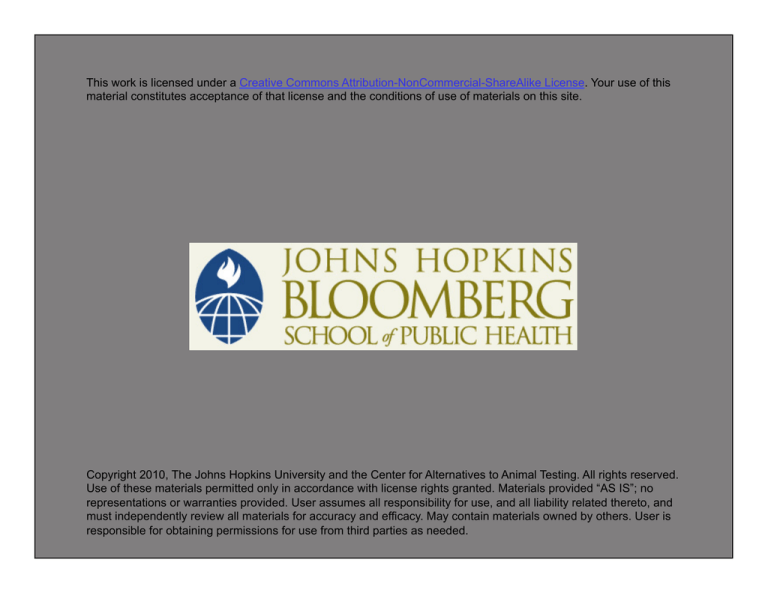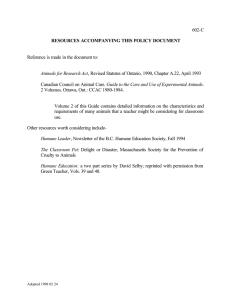
This work is licensed under a Creative Commons Attribution-NonCommercial-ShareAlike License. Your use of this
material constitutes acceptance of that license and the conditions of use of materials on this site.
Copyright 2010, The Johns Hopkins University and the Center for Alternatives to Animal Testing. All rights reserved.
Use of these materials permitted only in accordance with license rights granted. Materials provided “AS IS”; no
representations or warranties provided. User assumes all responsibility for use, and all liability related thereto, and
must independently review all materials for accuracy and efficacy. May contain materials owned by others. User is
responsible for obtaining permissions for use from third parties as needed.
Introduction to
Humane Science
Lecture 2
By
Andrew Rowan & Alan Goldberg
Course Purpose
• The course will demonstrate that taking appropriate
care of research animals is both a benefit to the
broader public attitudes to animal research and to
your own scientific aims.
• In addition, the course will outline the responsibilities,
i.e. the need to internalize the three Rs –
Replacement, Reduction and Refinement and the
ethic of preventing harm to lab animals as guiding
principles on how to proceed when doing animal
studies.
Lecture Outline
• Humane science entails paradigm shift
• Animal use trends and public attitudes to pain and suffering
• Animal Protection Movement (outline and growth)
• The Animal Research Debate & Ethical Approaches
• Concluding comments
Humane Science:
Changing Paradigms
• “Each ..[revolution] ..necessitated the community’s rejection of
one time-honored scientific theory in favor of another
incompatible with it. ... And each transformed the scientific
imagination in ways that we shall ultimately need to describe as
a transformation of the world within which scientific work was
done. Such changes, together with the controversies that
almost always accompany them, are the defining characteristics
of scientific revolutions.” (Thomas Kuhn, The Structure of
Scientific Revolutions.)
Sir Peter Medawar:
Changing Paradigms –
Animal Use
• In 1969, Nobel-prize winning immunologist Sir Peter Medawar
said: “...but this does not imply that we are for evermore, and in
increaasing numbers, to enlist animals in the scientific service of
man. I think that the use of experimental animals on the present
scale is a temporarary episode in biological and medical history,
and that its peak will be reached in ten years – or perhaps
sooner. In the meantime, we must grapple with the paradox that
nothing but research on animals will provide us with the
knowledge that will make it possible for us, one day, to
dispense with the use of them altogether.” (emphasis
added)
Trends in Lab
Animal Use
BARS ARE NORMALIZED TO RECORD HIGHPOINT OF ANIMAL USE AS 1.0 ROUNDED TO NEAREST TENTH – USA TRENDS ARE SIMILAR (from available data sources).
Animal Suffering
• For both scientists and the public, reducing and
eliminating pain and distress is very important.
• Deliberately inflicting pain/distress or ignoring it are
key issues driving public uneasiness with biomedical
research on animals.
• The answer is more explicit attention to the issue and
publicizing and taking pride in such attention.
Attitudes to Animal
Research - UK – 1999:
% of the Public Approving Mice Use For:
From New Scientist, 22 May, 1999, pp. 26-31
Q:
How strongly do you approve or disapprove of the
use of animals like mammals and birds in research and
testing when the animals experience severe, moderate,
little or no pain or distress?
Severe
Moderate
Little/No
Strongly disapprove
57
37
20
Somewhat disapprove
18
23
13
Total Disapprove
75
60
33
Strongly approve
8
11
30
Somewhat approve
13
23
32
Total Approve
21
34
62
Survey conducted for The HSUS by an independent polling firm, which
interviewed 757 Americans nationally on September 23, 2001.
Animal protection
movement
• Two broad groups
– animal welfare (e.g. HSUS, ASPCA, MSPCA,
Animal Welfare Institute) and
– animal rights/AV (e.g. PETA, In Defense of
Animals, American AV Society, NAVS)
• Separately, laboratory animal scientists (& CAAT)
view themselves as being part of the animal
protection movement.
Animal protection
movement growth
Growth in HSUS income from 1980 to 1998 (a few others, such
as PETA, show similar growth patterns).
Animal Use:
Legitimacy & The Debate
• Both scientists and animal advocates look forward to the day
when animals no longer used in research that causes them
harm ( see comments by FBR spokesperson, Boston Globe
editorial, 1999; Dr Colin Blakemore at 1998 PRIM&R meeting;
HSUS)
• The use of animals is a privilege granted by society
• This privilege comes with the responsibility to internalize the
Three Rs of Replacement, Reduction and Refinement and to
understand the ethical issues and arguments
Ethics:
How to approach
• Distinguish between individual motives (one must
assume all scientists are humane and all animal
activists are rational) and institutional “habits.”
• In Ethics discussions, one should assume that
opponents are as virtuous as you are.
• The arguments are not (or should not be) aimed
at individuals – they are challenges to
“Institutional” (society-wide) approaches.
Ethics
• Three common approaches in debate over animal
use in laboratories
– Utilitarianism (compare benefits & harms)
– Deontological (“rights” - based on a priori
rules)
– Scientific Anti-Vivisectionism (holds that
animal research is inherently misleading for
human health)
Ethics:
Utilitarianism - 1
• Jeremy Bentham (1789) – authored the “grand phrase of
animal welfare”
– “The question is not, Can they [animals] speak?, nor,
Can they reason?, but, Can they suffer?”
• Significant numbers of both sides in the debate use some
version of a Utilitarian argument to support their position
(Utilitarian “Lite”)
• Compare HARMS and BENEFITS
Ethics:
Utilitarianism - 2
• Peter Singer (Utilitarian philosopher and animal
activist) criticizes animal research – he claims it
cause lots of animal suffering (harms) and
relatively little benefit to humans or animals
• Most scientists defend animal research – they
argue that it produces lots of benefit for humans
and animals and little animal suffering (i.e.harms)
• It should be possible to determine who is correct
Ethics:
Utilitarianism - 3
• However, estimating the amount of ANIMAL SUFFERING and
the extent of the BENEFITS of research proves to be very hard.
(The benefits are clearly very significant but putting hard
numbers/metrics to them has not been satisfactorily
accomplished – see McKeown, 1979.)
• In addition, neither the scientific community nor the animal
activists have yet come to grips with either of the above.
• Both sides tend to resort to anecdotes to support their point but,
as everyone knows, proving a general claim using a few
anecdotes is fraught with dangers.
Thomas McKeown, 1979. The Role of Medicine: Dream, Mirage or
Nemesis? Princeton University Press.
Ethics:
Deontological
• Humans and animals have rights that cannot (by
definition) be over-ridden by claims to utility or usefulness
(Tom Regan, 1993, is major philosopher proposing this
view)
• There is a fundamental disconnect between those who
argue that animal research is useful and those saying it
conflicts with animal rights (deontological argument)
• This disconnect cannot be resolved using empirical data
– one has to deal with it from a “values/metaphysical”
position. It involves a conflict between human claims or
rights and animal rights. Not clear how to resolve.
Ethics:
Scientific Anti-vivisectionism (SAV)
• The basic SAV premise is that animal models cannot
produce data or insights that are useful for humans
because of the biological differences between humans
and animals.
• Debates between proponents of SAV and animal research
have not been productive. Animal research advocates
usually do not know (and hence cannot counter) the
details of the SAV examples put forward and, more
importantly, also do not want to dignify the SAV
arguments by responding.
• There are similarities between scientific reactions to the
SAV and to Creationist arguments.
Current Debate
• The extreme positions are unalterably opposed (The
Economist 1996) – e.g. absolute research freedom
versus scientific anti-vivisectionism.
• Many of those involved in the debate are separated
more by caricature, ignorance and distrust than by
fact or fundamental principle.
• Utilitarian issues are, to considerable extent, the
basis for legislative approaches in USA and EU.
Important
Legislation
USA
UK & EU
1876 – UK Cruelty to Animals
Act
1966 – Animal Welfare Act
1985 – AWA Amendments –
Emphasize Pain & Distress
1986 – UK Act revised
1986 – EU Directive
1999 – EU Humane Endpoints
Russell & Burch
• “[T]he humanest possible treatment of
experimental animals, far from being an
obstacle [to biomedical research], is
actually a prerequisite for successful
animal experiments.” (pp. 3-4) (The
Principles of Humane Experimental Technique,
1959)
Three Rs
& Science
• The Three Rs focus on the most modern, newest
technologies – from molecular biology to a range of
interesting and compelling approaches such as MRI,
biophotonics, metabonomics, and the like.
• The Three Rs SUPPORT science – and, when properly
applied, enhance and strenghten scientific progress.
Conclusion
• Medawar shows the way. We all, scientist and
animal protection advocate alike, would like to see
the day when animals are no longer used in studies
that cause them harm.
• The debate is falsely framed as either using or not
using animals. It is more accurately and USEFULLY
defined as:- “How much effort should we put into
avoiding animal suffering and animal harm while
promoting good science?”





